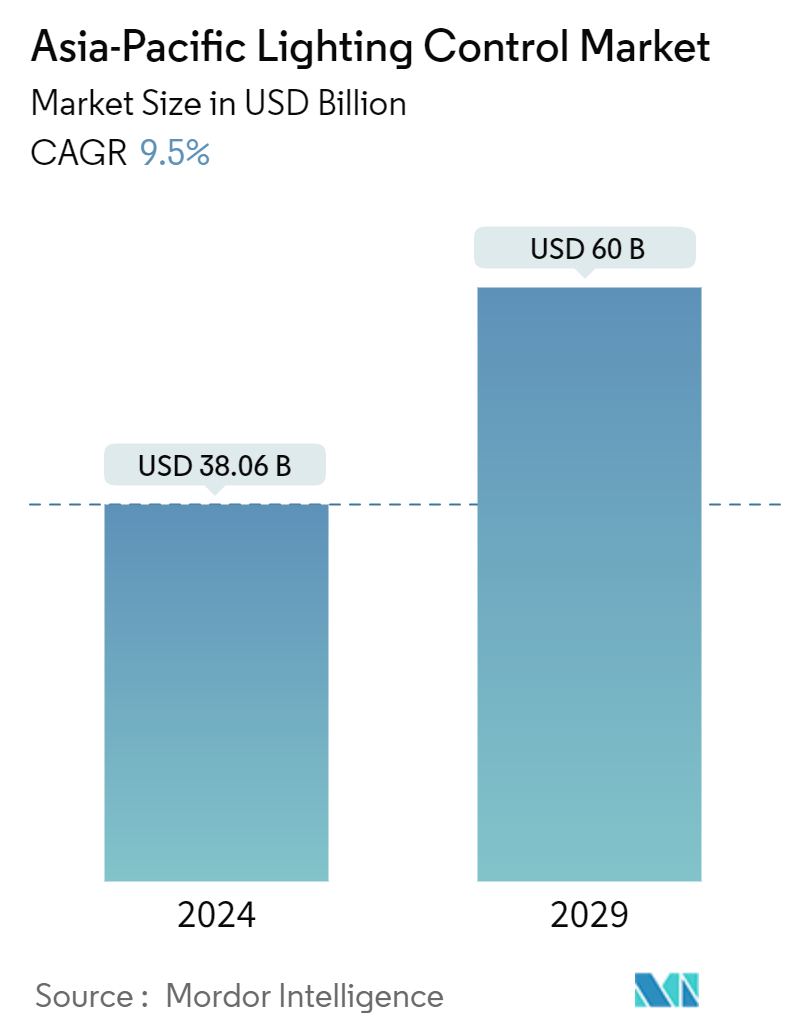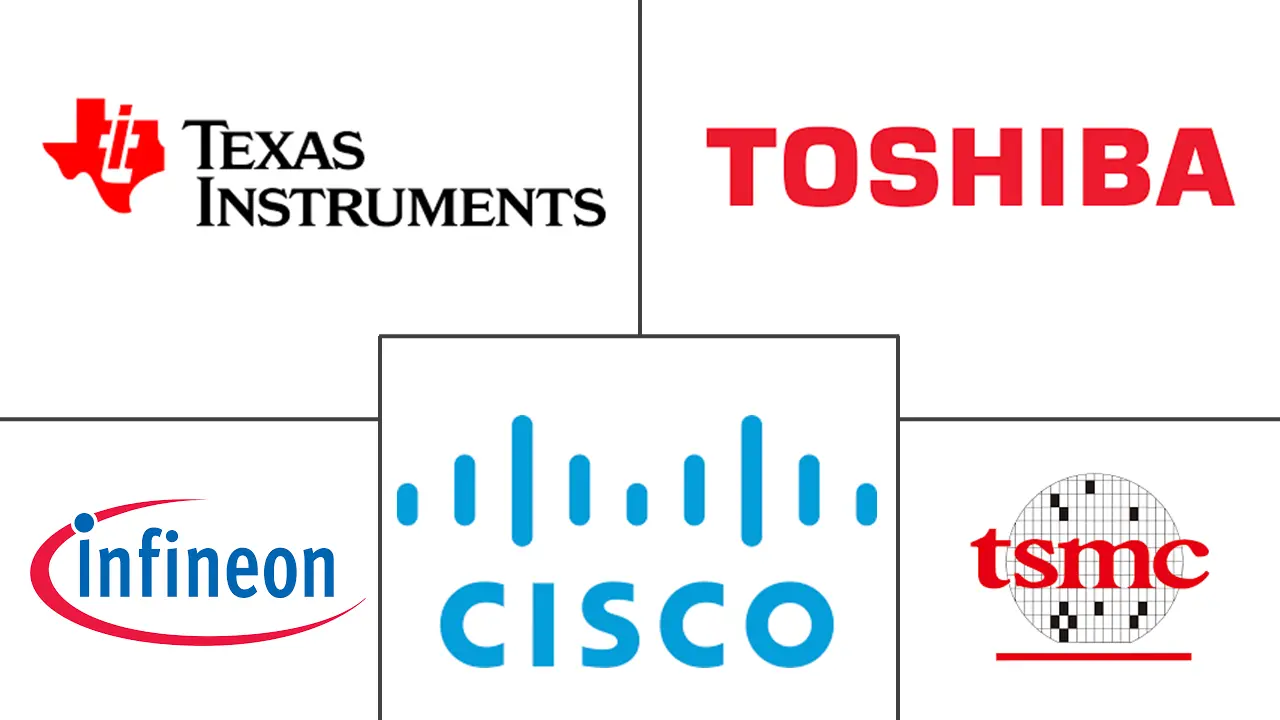Market Size of Asia-Pacific Lighting Control Industry

| Study Period | 2024 - 2029 |
| Base Year For Estimation | 2023 |
| Market Size (2024) | USD 38.06 Billion |
| Market Size (2029) | USD 60 Billion |
| CAGR (2024 - 2029) | 9.50 % |
| Market Concentration | Low |
Major Players
*Disclaimer: Major Players sorted in no particular order |
Asia-Pacific Lighting Control Market Analysis
The Asia-Pacific Lighting Control Market size is estimated at USD 38.06 billion in 2024, and is expected to reach USD 60 billion by 2029, growing at a CAGR of 9.5% during the forecast period (2024-2029).
The Asia-Pacific lighting control market is projected to witness high growth due to increased demand for home automation and the emergence of IoT in the region. In addition, lighting control helps save energy, as it consists of several ways to switch and dimmer modules to control lighting fixtures.
- Lighting control plays an essential role in today's modern residential and commercial buildings. It allows the end-user to control the lights in their space to best meet the needs of the environment and application and helps meet the current energy code requirements.
- Lighting controls are used to maximize energy savings, provide safety & security, satisfy building codes, or comply with green building and energy conservation programs. It also offers several other benefits, including extended bulb life, energy savings, security, and programmable reference, and it can adjust light levels relative to tasks.
- The rising construction activities in developing economies such as Korea, India, China, and Japan are expected to boost the demand for lighting control during the projected timeline. The growing urbanization rate is also among the contributing factors behind the growth of the lighting industry, as lights are more prevalent in urban areas than rural areas. According to the World Bank, about 600 million people will be living in metropolitan cities in India by 2036, representing 40% of the population.
- Furthermore, the increasing building renovation and new city projects by the governments to strengthen their infrastructure in the region are expected to drive the market’s growth. For instance, Indonesia and South Korea announced a strategic partnership to expand cooperation on a new capital city project.
- Moreover, a few other factors providing growth opportunities for the lighting control market in the region include the speedy development of wireless technology and sensors and increasing demand for smart lighting solutions for developing smart cities and street lighting.
- The COVID-19 pandemic significantly influenced the lighting control market. However, the market observed significant growth after the pandemic due to a rise in many construction projects across several regions. The rise in construction activities across the residential, commercial, and industrial sectors is expected to boost the demand for lighting control.
Asia-Pacific Lighting Control Industry Segmentation
Lighting controls are used to control the lighting within a given area independently. They provide the desired amount of light where and when it is needed. Lighting control can be used for outdoor and indoor lighting of residential, commercial, and industrial areas.
The Asia-Pacific lighting control system market is segmented by type [hardware (LED driver, sensors and switches and dimmers, relay units, and gateways), and software], communication protocol (wired and wireless), application (indoor and outdoor), and country. The market sizes and forecasts are provided in terms of value USD for all the above segments.
| By Type | |||||||
| |||||||
| Software |
| By Communication Protocol | |
| Wired | |
| Wireless |
| By Application | |
| Indoor | |
| Outdoor |
| Country*** | |
| China | |
| Japan | |
| India | |
| South Korea | |
| Indonesia | |
| Australia and New Zealand |
Asia-Pacific Lighting Control Market Size Summary
The Asia-Pacific lighting control market is poised for significant expansion, driven by the increasing demand for home automation and the integration of IoT technologies. This growth is further supported by the rising need for energy-efficient solutions, as lighting control systems offer various methods to manage and optimize lighting usage. These systems are crucial in modern residential and commercial buildings, helping to meet energy code requirements and providing benefits such as extended bulb life, enhanced security, and compliance with green building standards. The market's expansion is also fueled by rapid urbanization and construction activities in developing economies like China, India, Korea, and Japan, where urban areas are becoming more prevalent. Government initiatives and infrastructure projects in these regions are expected to further propel the demand for advanced lighting control solutions.
The market landscape is characterized by intense competition, with major players like Texas Instruments Inc., Schneider Electric SE, and Philips NV leading the charge through strategic partnerships, product launches, and significant investments in research and development. The COVID-19 pandemic initially impacted the market, but subsequent recovery has been driven by a surge in construction projects across various sectors. The development of smart cities and the adoption of wireless technology and sensors are also contributing to market growth. In China, the focus on smart city initiatives and substantial infrastructure investments are key drivers, while in India, government-led infrastructure programs are set to boost the market further. The introduction of innovative products, such as Legrand’s Vantage Voice and Leviton’s smart outdoor plugs, highlights the ongoing advancements in lighting control technologies, catering to the growing demand for smart and automated solutions.
Asia-Pacific Lighting Control Market Size - Table of Contents
-
1. MARKET INSIGHTS
-
1.1 Market Overview
-
1.2 Value Chain/Supply Chain Analysis
-
1.3 Industry Attractiveness - Porter's Five Forces Analysis
-
1.3.1 Threat of New Entrants
-
1.3.2 Bargaining Power of Buyers/Consumers
-
1.3.3 Bargaining Power of Suppliers
-
1.3.4 Threat of Substitute Products
-
1.3.5 Intensity of Competitive Rivalry
-
-
1.4 Impact of Macro-economic Trends on the Market
-
-
2. MARKET SEGMENTATION
-
2.1 By Type
-
2.1.1 Hardware
-
2.1.1.1 LED Drivers
-
2.1.1.2 Sensors
-
2.1.1.3 Switches and Dimmers
-
2.1.1.4 Relay Units
-
2.1.1.5 Gateways
-
-
2.1.2 Software
-
-
2.2 By Communication Protocol
-
2.2.1 Wired
-
2.2.2 Wireless
-
-
2.3 By Application
-
2.3.1 Indoor
-
2.3.2 Outdoor
-
-
2.4 Country***
-
2.4.1 China
-
2.4.2 Japan
-
2.4.3 India
-
2.4.4 South Korea
-
2.4.5 Indonesia
-
2.4.6 Australia and New Zealand
-
-
Asia-Pacific Lighting Control Market Size FAQs
How big is the Asia-Pacific Lighting Control Market?
The Asia-Pacific Lighting Control Market size is expected to reach USD 38.06 billion in 2024 and grow at a CAGR of 9.5% to reach USD 60 billion by 2029.
What is the current Asia-Pacific Lighting Control Market size?
In 2024, the Asia-Pacific Lighting Control Market size is expected to reach USD 38.06 billion.

